Tryptophan (Trp) Operon Definition
A collection of genes that are transcribed together encode the components for tryptophan synthesis.
- The E. coli trp operon is a cluster of genes that code for biosynthetic enzymes for the amino acid tryptophan.
- When tryptophan levels are low, the trp operon is expressed (turned “on”) and when they are high, it is repressed (turned “off”).
- The trp repressor controls the trp operon. When coupled to tryptophan, the trp repressor inhibits operon expression.
- Attenuation also controls the tryptophan biosynthesis (a mechanism based on coupling of transcription and translation).
- Bacteria such as Escherichia coli (a beneficial gut flora) require amino acids to exist because, like humans, they must construct proteins. Tryptophan is one of the amino acids they require.
- If tryptophan is present in the environment, E. coli will utilise it to produce proteins. However, E. coli can also produce tryptophan by the use of enzymes expressed by five genes. These five genes are positioned next to one another in the trp operon.
- If tryptophan is present in the environment, E. coli bacteria do not need to generate it; hence, transcription of the trp operon genes is “turned off.” In contrast, when tryptophan is scarce, the operon is activated, the genes are transcribed, biosynthetic enzymes are generated, and more tryptophan is created.
- This operon exemplifies repressible negative gene expression regulation.
- In the presence of tryptophan, the repressor protein attaches to the operator (repressing transcription) and is released from the operon in the absence of tryptophan (allowing transcription to proceed).
- The trp operon additionally uses attenuation, a second negative feedback control mechanism, to regulate the expression of the operon.
- The trp operon contains five structural genes that encode the enzymes required to produce tryptophan: trpE, trpD, trpC, trpB, and trpA.
- Additionally, it contains the repressive regulator gene trpR. When tryptophan is present, the trpR protein binds to the operator, preventing RNA polymerase from transcribing the trp operon.
- This operon possesses two levels of regulation:
- Repression: works at the transcription initiation level
- Attenuation: works at the transcription termination level
Note: The trp operon is a set of genes that, when transcribed together, encode the enzymes that cause bacteria to generate the amino acid tryptophan. The trp operon was initially defined in Escherichia coli, and it has since been identified in a variety of other species. When tryptophan is available in the environment, the genes for tryptophan synthesis are inhibited via regulation of the operon.
Structure of the trp operon
The trp operon consists of five genes encoding enzymes required for tryptophan production, as well as a promoter (RNA polymerase binding site) and an operator (binding site for a repressor protein). The trp operon’s genes are transcribed as a single mRNA.

Structural genes
Five structural genes comprise Trp operon. Their functions are:
- TrpE: Encodes the Anthranilate synthase enzyme I. Anthranilate is produced by anthranilate synthase.
- TrpD: Anthranilate synthase II is encoded by TrpD. Compatible with TrpE.
- TrpC: TrpC is responsible for encoding the enzymes N-5′-Phosphoribosyl anthranilate isomerase and Indole-3-glycerolphosphate synthase. First, the domain of phosphoribosylanthranilate isomerase converts N-(5-phospho—D-ribosyl)anthranilate into 1-(2-carboxyphenylamino)-1-deoxy-D-ribulose 5-phosphate. On the same protein, the Indole-3-glycerol-phosphate synthase converts the product into (1S,2R)-1-C-(indol-3-yl)glycerol 3-phosphate.
- trpB: trpB encodes the component of the enzyme tryptophan synthase-B.
- trpA: trpA encodes the component of the enzyme tryptophan synthase-A.
| trp Operon Gene | Gene Function |
|---|---|
| P/O | Promoter; operator sequence is found in the promoter |
| trp L | Leader sequence; attenuator (A) sequence is found in the leader |
| trp E | Gene for anthranilate synthetase subunit |
| trp D | Gene for anthranilate synthetase subunit |
| trp C | Gene for glycerolphosphate synthetase |
| trp B | Gene for tryptophan synthetase subunit |
| trp A | Gene for tryptophan synthetase subunit |
Regulatory DNA sequences
Promoter Gene
- It refers to the region of a bacterial chromosome containing a particular nucleotide sequence to which an RNA polymerase can bind to commence transcription.
- The association of a repressor protein with the operator blocks the association of RNA polymerase with the promoter region, hence stopping transcription.
Operator Gene
- It is the precise sequence of nucleotides on the chromosomal DNA of E. coli to which a repressor protein can bind in the presence of an effector molecule or tryptophan.
- The tryptophan molecule functions as a corepressor to aid in the activation of the aporepressor protein.
Regulatory Gene
- A regulatory gene on the chromosome encodes the trp repressor protein that recognises the operator sequence in the tryptophan operon.
- The repressor protein activates the operon system when the surrounding trp concentration is low and deactivates the system when the trp concentration is high.
- Consequently, a repressor protein is related with the synthesis of five gene products, which is dependent on the surrounding quantity of tryptophan.
- Repressor activity is dependent on the presence or absence of a corepressor or effector molecule (tryptophan).
Attenuator Region
- It is located between the operator region and the structural genes.
- The attenuator region consists of 160-bp leader sequences that regulate transcription via attenuation.
- Its mechanism consists of generating dimers within the bacterial cell at sufficient levels of tryptophan in order to reduce transcriptional effectiveness.
- In contrast, the RNAp can cross the attenuator region and transcribe the genes required for trp synthesis at low tryptophan levels.
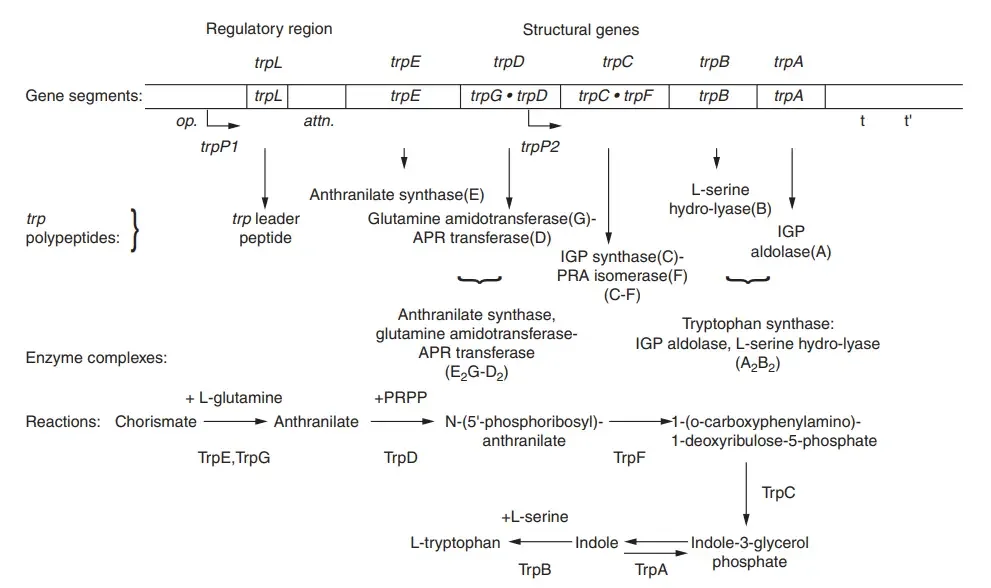
Turning the operon “on” and “off”
- The trp repressor is a regulatory protein that recognises the operator. When the repressor binds to the operator’s DNA, it prevents the operon from being transcribed by physically interfering with the transcription enzyme, RNA polymerase.
- The trp repressor protein is encoded by the trpR gene. This gene is located elsewhere on the bacterial chromosome, with its own promoter and other regulatory regions, and is not part of the trp operon.
- Not always does the trp repressor attach to DNA. Instead, it exclusively binds and inhibits transcription in the presence of tryptophan.
- When tryptophan is present, it binds to repressor molecules and alters their structure, activating them.
- A corepressor is a tiny chemical, such as trytophan, that flips a repressor into its active state.
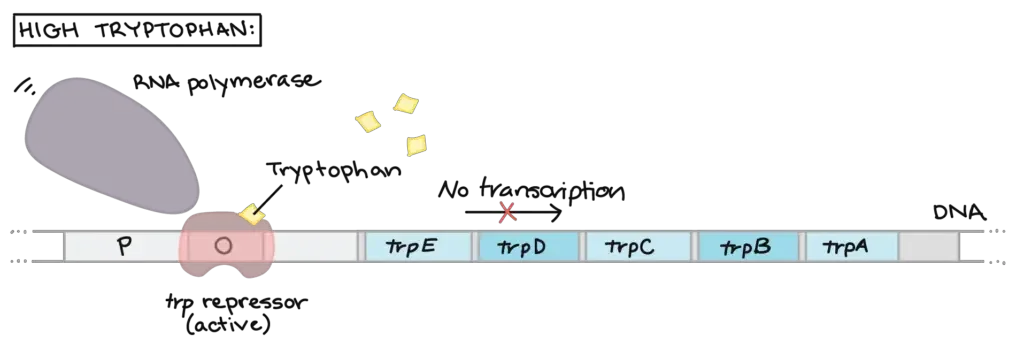
- However, when there is minimal tryptophan in the cell, the trp repressor is inactive (because no tryptophan is available to bind to and activate it).
- It does not bind to DNA or inhibit transcription, allowing RNA polymerase to transcribe the trp operon.

- The trp repressor in this system serves as both a sensor and a switch. If tryptophan is already present in large concentrations, it switches the operon to the “off” state, preventing the production of superfluous biosynthetic enzymes.
Regulation of Tryptophan Operon
2 mechanisms regulate the trp operon.
- Repressor or derepression mechanism
- Attenuation mechanism
Repression of Trp Operon
- The repressive regulation is detrimental.
- The trpR gene, which codes for the repressor of the trp operon, is positioned far from the operon itself.
- P1 refers to the major promoter region, which includes the operator (O) region.
- P2 is a weak promoter found at the farthest end of the trpD gene from the operator. Its role is to elevate the basal transcription levels of trpC, trpB, and trpA.
- Two termination areas, t and t’, are located downstream of the trpA gene. The trpL indicates a region containing an mRNA leader sequence (162 nucleotides in length).
- It functions as a co-repressor. RNA polymerase attaching to the promoter stimulates transcription of structural genes in its absence.
- When tryptophan is present, it forms a corepressor/repressor complex with the repressor.
- This complex binds to the operator sequence and inhibits the initiation of transcription by RNA polymerase.
- In the presence of tryptophan (repressed state), RNA polymerase activity is approximately 70 times slower than in the absence of tryptophan (de-repressed state).
- In trpR mutants, there is no functional repressor, yet the addition of tryptophan can still cause a 10 fold reduction in transcription rate due to attenuation.
Mechanism
- It occurs when the concentration of trp in the surrounding medium is high.
- In this instance, the TrpR gene of the tryptophan operon produces apo-repressor (inactive) protein, which cannot bind to the operator region on its own.
- The apo-repressor protein activates and inhibits the RNA polymerase in the presence of a corepressor or tryptophan.
- Thus, RNAP cannot activate the transcription of structural genes and inhibits enzymes required for trp synthesis. At a high tryptophan concentration, the relevant RNA polymerase cannot bind to the operator gene or transcribe structural genes.
- Expression of the trp operon when tryptophan is available suggests that the operon system will end transcription.
- The repression of the trp operon is therefore mediated by a complex composed of an allosteric repressor and an effector molecule. Tryptophan acts as a corepressor or effector molecule that converts the inactive apo-repressor into an active repressor, which binds to the operator sequence to inhibit gene expression.
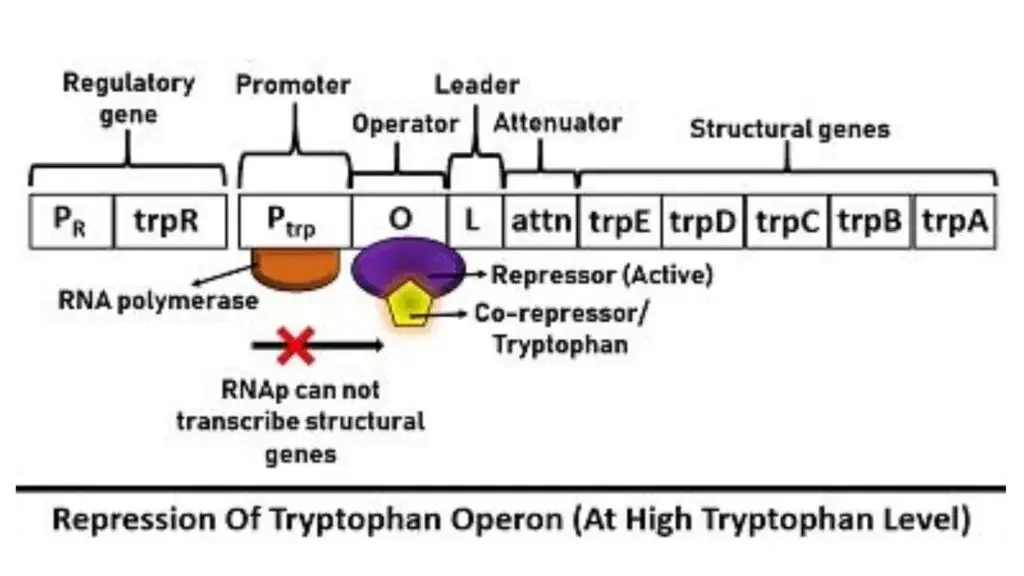
Derepression of Trp Operon
- It occurs when there are low quantities of tryptophan in the environment.
- Due to a deficiency in effector molecules, the active repressor protein will detach from the operator region.
- After separation, the repressor is rendered inactive and without function. Consequently, RNA polymerase is liberated to continue transcribing structural genes to create tryptophan.
- Expression of the trp operon in the absence of tryptophan results in the activation of the operon system to undertake transcription of structural genes by RNA polymerase.
- Thus, derepression is brought about by the dissociation of repressor protein due to the absence of trp or effector molecules, which can form an active complex.
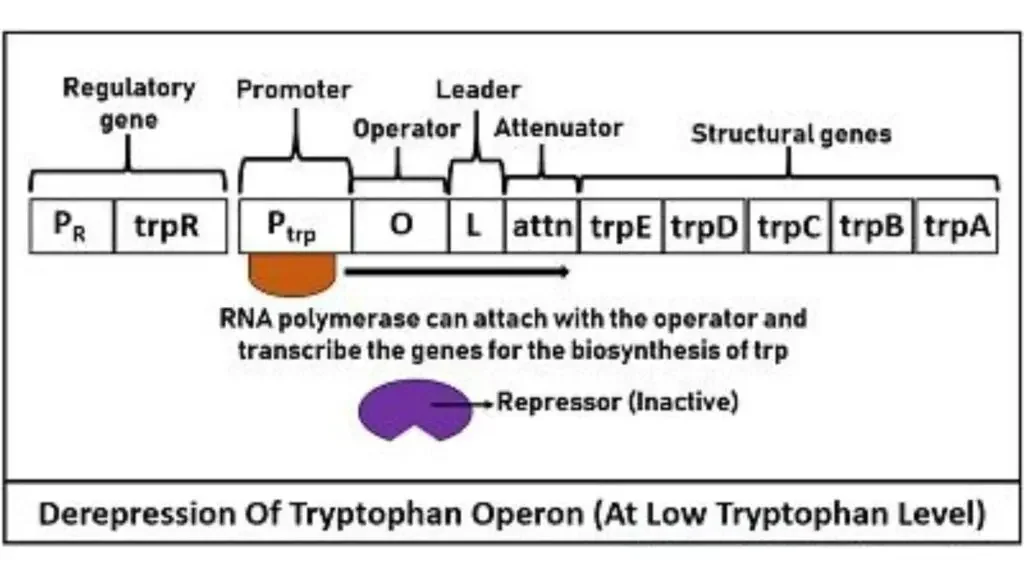
Attenuation of trp Operon
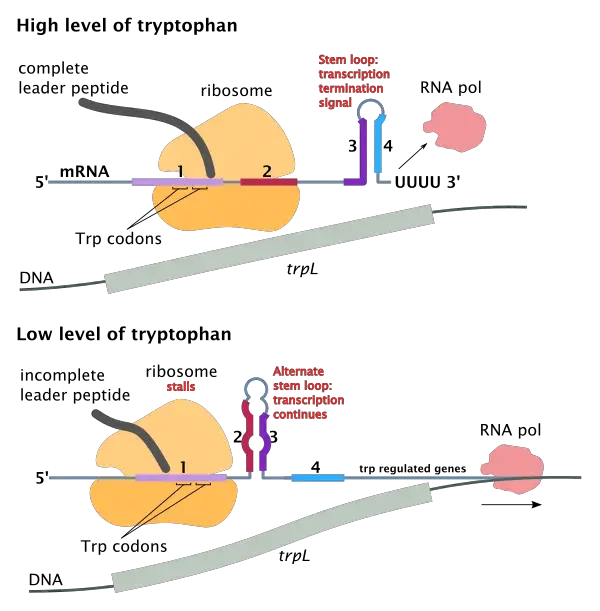
- It is the second part of the trp operon that controls how the gene works. The trpL gene or attenuator controls this part.
- The expression of a gene is controlled by an attenuation mechanism that is part of a leader sequence.
- It is made up of a polypeptide sequence and an attenuator (contains palindromic sequences).
- Once the bacterial DNA is turned into mRNA, the palindromic sequences in the attenuator sequence can pair up and form dimers.
- In the leader sequence, there are four domains. Domain 3 can pair with either domain 2 or 4, and domain 1 can pair with domain 2. Also, there are two trp residues in it.
- When domains 2 and 3 work together, this is called antitermination. On the other hand, when domains 3 and 4 come together, trp biosynthesis stops.
- Domain-4, which is also called an attenuator, is needed to stop transcription because it is the only thing that can help form a stem-loop.
- The way the attenuation works depends on how the ribosomes pair up and how much tryptophan is in a bacterial cell.
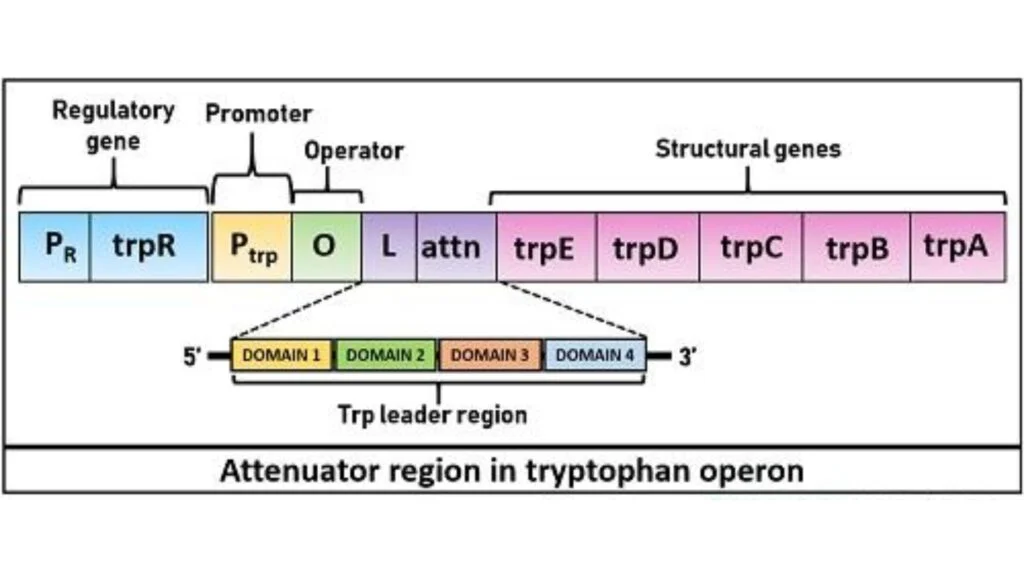
At low tryptophan level
- Domain 1 of the mRNA transcript is where the ribosome sits.
- Then, because there isn’t much tryptophan, it translates the mRNA very slowly. Because the ribosome stops at domain-1, domain-3 interacts with domain-2.
- In this case, there won’t be a stem and loop structure. So, the transcription may continue to make enzymes that are needed for making trp.
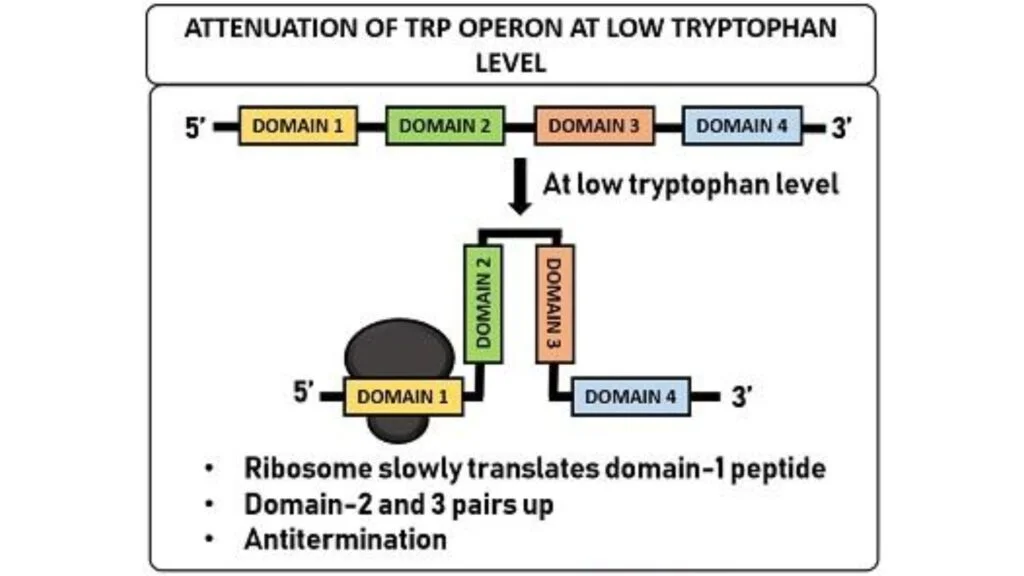
At high tryptophan level
- When there is a lot of tryptophan in the cell, the ribosome moves quickly through domain 1 and stops at domain 2.
- Because of this, domain-3 connects to domain-4 and helps make a hair-loop structure.
- The dimerization of domains 3 and 4 makes the RNAp fall off and stops mRNA from transcribing genes that make enzymes for trp biosynthesis.
- Due to the pairing of self-complementary sequences, an attenuator acts as a barrier when there is a lot of trp.
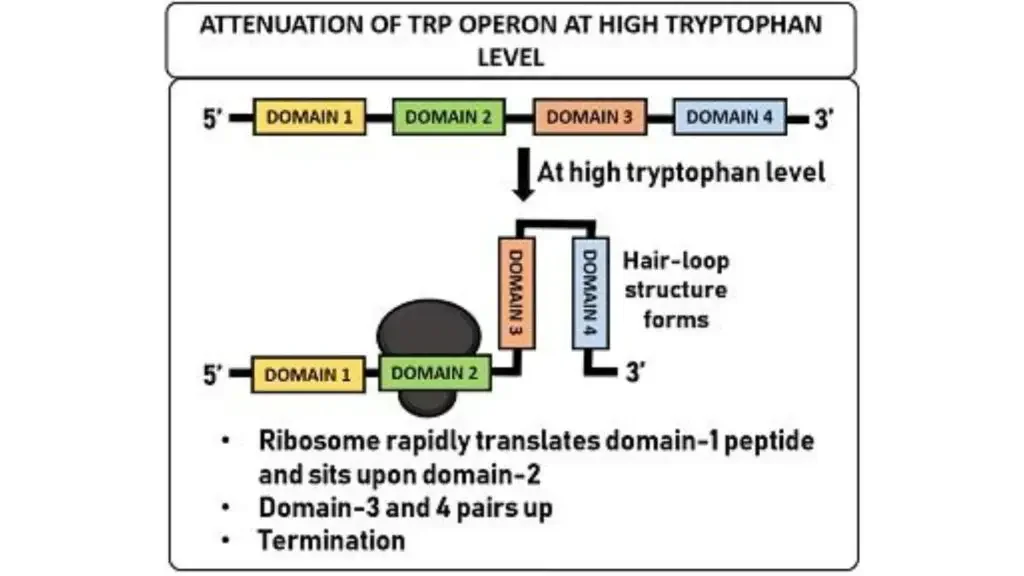
The Arabinose Operon: An Example Of Positive And Negativecontrol
The arabinose operon is hard to understand because it is so complicated. Only the basic information is given below.
- Arabinose is broken down (catabolized) by the structural genes araB, araA, and araD.
- Arabinose structural gene transcription can be both repressed (negative control) and stimulated (positive control) by the regulator protein araC.
- In the absence of arabinose, the araC protein binds to araO2 (an operator) and araI (an insertion site). It is believed that this leads to a change in the secondary structure of PBAD (the promoter for structural genes) that prohibits or interferes with RNA polymerase binding at PBAD.
- In the presence of arabinose and cyclic AMP, araC becomes a transcriptional activator. In this instance, an arabinose-araC protein complex and a cyclic AMP-CAP protein complex with binding sites at the araI site are involved. The “model” proposes that the two complexes influence the binding of RNA polymerase to PBAD in a beneficial manner.
The Pathway and Enzymes of Tryptophan Biosynthesis
- The biosynthetic process for tryptophan begins with chorismate, the common precursor for the three aromatic amino acids.
- Chorismate is also a precursor to a number of minor aromatic metabolites, such as p-aminobenzoic acid, a component of folic acid.
- The molecular pathways from chorismate to tryptophan, as well as the seven polypeptide domains that catalyse these pathways.
- A tetrameric enzyme complex comprised of two TrpE and two TrpG–TrpD polypeptides catalyses the synthesis of anthranilate from chorismate and phosphoribosyl anthranilate from anthranilate.
- Even though L-glutamine is the amino group donor of choice during the synthesis of anthranilate (o-aminobenzoate) from chorismate, ammonia can be used by the complex or the TrpE polypeptide alone as an alternative source of this amino group.
- Glutamine consumption requires the TrpG glutamine amidotransferase domain.
- The TrpD domain provides 5-phosphoribosyl-1-pyrophosphate (PRPP) to the side chain of phosphoribosyl anthranilate during the conversion of anthranilate to phosphoribosyl anthranilate.
- Anthranilate phosphoribosyltransferase, the TrpF domain, then rearranges phosphoribosyl anthranilate to create 1-(o-carboxyphenylamino)-1-deoxyribulose-5-phosphate (CdRP).
- The carboxyl group of CdRP is subsequently removed, and the pyrrole ring of the indole moiety is produced, resulting in indole-3-glycerol phosphate, the next stage in the route.
- The TrpC domain of indoleglycerol phosphate synthase catalyses the latter process.
- The TrpA polypeptide of the tryptophan synthase enzyme complex converts indole glycerol phosphate to indole. This tetrameric complex consists of two molecules of TrpA and two molecules of TrpB.
- L-tryptophan is formed by condensing indole with a pyridoxal phosphate derivative of L-serine; the final reaction is catalysed by the TrpB polypeptide of the tryptophan synthase complex.
- The synthesis of tryptophan from chorismate requires the chemicals L-glutamine, phosphoribosyl-1-pyrophosphate, L-serine, and pyridoxal phosphate, which are the end products of four more metabolic processes.
- The amino group of anthranilate comes from glutamine. Two carbon atoms of the pyrrole ring of indole come from phosporibosyl pyrophosphate. The alanyl side chain of tryptophan comes from L-serine. Pyridoxal phosphate is the coenzyme that is needed to activate L-serine and speed up the final reaction in the formation of tryptophan.
Structure/Function of Tryptophan Biosynthetic Enzymes
- The mechanism of enzymatic catalysis of each of the tryptophan biosynthetic processes has been studied, as well as the active site residues of each biosynthetic protein and protein domain.
- The three-dimensional structure of the Salmonella typhimurium tryptophan synthase enzyme complex and the structures of complexes harbouring mutant protein variations have been determined.
- E. coli’s bifunctional phosphoribosyl anthranilate isomerase-indoleglycerol phosphate synthase has also been characterised in three dimensions.
- These structures have indicated that the polypeptide domains of TrpA, TrpC, and TrpF have similar structures of the / triosephosphate isomerase (TIM) barrel type, suggesting the idea that they developed from one another or a shared ancestor.
- The active site of the TrpA polypeptide and the active site of the TrpB polypeptide are connected by a tunnel, according to structural studies of the tryptophan synthase enzyme complex.
- Indole is transported down this tunnel from the TrpA active site to the TrpB active site, where it is condensed with serine.
- Studies of this enzyme complex have also revealed characteristics of the complex that explain the mutual activation of each polypeptide upon creation of a complex with a heterologous polypeptide.
Trp Operon Summary
- In repressible operons, such as the tryptophan (or trp) operon, the repressor cannot bind to the operator DNA alone.
- In contrast, the repressor is only active as a DNA-binding protein when complexed with a particular component, such as tryptophan, which serves as a corepressor.
- In the absence of tryptophan, the operator site is accessible to RNA polymerase, which then binds and transcribes the structural genes of the trp operon, resulting in the creation of the enzymes that manufacture tryptophan.
- The enzymes of the tryptophan synthesis pathway are no longer necessary once tryptophan becomes accessible.
- Under these conditions, the increased tryptophan concentration results in the development of the transcription-blocking tryptophan–repressor complex.
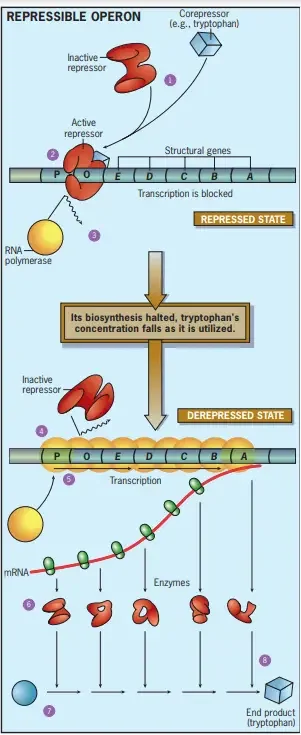
What happens in the Presence of Tryptophan?
In the presence of tryptophan, a specific regulatory mechanism comes into play to control the expression of genes involved in tryptophan biosynthesis. Here’s an overview of what happens:
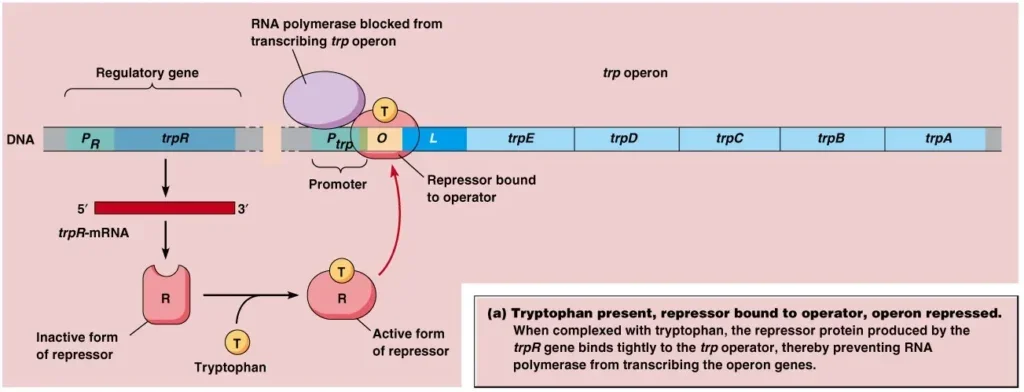
- In the presence of tryptophan, the enzymes responsible for tryptophan biosynthesis are not required. Consequently, the expression of genes encoding these enzymes needs to be turned off.
- Tryptophan acts as a key player in this process by binding to a regulatory protein called the trp repressor. This binding activates the repressor, allowing it to bind to the operator region of the trp operon.
- The trp operator region overlaps with the promoter region, which is the site where RNA polymerase binds to initiate transcription. When the trp repressor binds to the operator, it effectively blocks the access of RNA polymerase to the promoter.
- As a result of the bound repressor, the transcription of the structural genes within the trp operon is halted. These genes are responsible for the synthesis of enzymes involved in tryptophan production.
- Tryptophan functions as a co-repressor in this context. It enhances the activity of the repressor, enabling it to bind to the operator and prevent transcription. This mechanism is referred to as negative control since the presence of tryptophan leads to the inhibition of gene expression.
In summary, when tryptophan is present, it acts as a co-repressor, binding to the trp repressor protein and triggering its activation. This activated repressor then binds to the operator, blocking RNA polymerase from binding to the promoter, thereby halting the transcription of genes involved in tryptophan biosynthesis.
What happed when Trypophan is abundant?
When tryptophan is abundant, a specific regulatory mechanism controls the transcription of the trp operon. Here’s a summary of what happens:
- As the trp polycistronic mRNA is transcribed, ribosomes bind to it and initiate translation of the leader sequence.
- The leader sequence contains two trp codons within sequence 1, followed by a translational stop codon between sequence 1 and sequence 2.
- During translation, ribosomes closely trail the RNA polymerase, synthesizing the leader peptide. Eventually, translation stops between sequences 1 and 2.
- The ribosome’s position at this point prevents sequence 2 from interacting with sequence 3.
- Instead, sequence 3 base pairs with sequence 4, forming a 3:4 stem loop structure. This stem loop acts as a transcription terminator.
- Consequently, in the presence of abundant tryptophan, further transcription of the trp operon is prevented.
What happed When Trypophan is scarce?
- When tryptophan is scarce, it has a significant impact on the transcription of the trp operon. The trp operon is a cluster of genes involved in the synthesis of tryptophan, an essential amino acid. It consists of several regions or sequences that play crucial roles in regulating gene expression.
- Under normal conditions, when tryptophan levels are sufficient, the ribosome encounters two trp codons within sequence 1 of the trp operon. These trp codons act as signals for the ribosome to stall or pause briefly during translation. This pausing allows sequence 2 to form a base pairing with sequence 3, resulting in the formation of a 2:3 structure. This structure prevents the formation of a 3:4 structure and ultimately leads to the termination of transcription.
- However, when tryptophan is scarce, the ribosome does not encounter enough tryptophan molecules to trigger the pausing at the trp codons in sequence 1. As a result, sequence 2 remains unpaired with sequence 3, and the 2:3 structure (also known as the anti-terminator) is not formed. This absence of the 2:3 structure allows the formation of the 3:4 structure, which prevents the premature termination of transcription.
- In other words, when tryptophan is limited, the availability of tryptophan controls whether transcription of the trp operon will stop early (a process known as attenuation) or continue until the synthesis of a complete polycistronic mRNA. In the absence of sufficient tryptophan, transcription continues, enabling the production of the necessary enzymes involved in tryptophan biosynthesis.
- This regulatory mechanism ensures that the trp operon is only transcribed when tryptophan levels are low, allowing the cell to prioritize the synthesis of tryptophan when it is needed. When tryptophan becomes readily available, it binds to a regulatory protein called a repressor, which prevents the transcription of the trp operon, thus conserving cellular resources.
- In summary, when tryptophan is scarce, the ribosome bypasses the pausing signals at the trp codons, leading to the formation of a 3:4 structure and the continuation of transcription. This allows the cell to synthesize the enzymes necessary for tryptophan biosynthesis and maintain an adequate supply of this essential amino acid.
FAQ
What happens in the absence of tryptophan?
In the absence of tryptophan, what occurs is the synthesis of a trp repressor protein encoded by the trpR operon. This protein forms a dimer, but it remains inactive and unable to bind to the trp operator. As a result, the structural genes of the trp operon are transcribed.
What happens in the Presence of Tryptophan?
In the presence of tryptophan, the trp repressor protein is activated by tryptophan binding. This activated repressor binds to the operator region, preventing RNA polymerase from binding to the promoter and halting transcription of the tryptophan biosynthesis genes. Tryptophan acts as a co-repressor in this negative control mechanism.
What is the tryptophan (Trp) operon?
The tryptophan operon is a genetic system found in bacteria that regulates the synthesis of tryptophan, an essential amino acid.
What is an operon?
An operon is a cluster of genes that are transcribed together and regulated as a single unit. It consists of an operator region, a promoter region, and the genes involved in a specific metabolic pathway.
How is the Tryptophan Operon regulated?
The Tryptophan Operon is regulated by a repressor protein called the Trp repressor. When tryptophan levels are high, tryptophan molecules bind to the Trp repressor, causing it to bind to the operator region of the operon and block gene transcription.
What happens when tryptophan levels are low?
When tryptophan levels are low, there is no tryptophan available to bind to the Trp repressor. As a result, the Trp repressor is unable to bind to the operator region, allowing RNA polymerase to transcribe the genes of the operon.
What is the role of the Tryptophan Operon genes?
The genes of the Tryptophan Operon encode enzymes involved in the biosynthesis of tryptophan. These enzymes catalyze the conversion of precursor molecules into tryptophan.
Why is the Tryptophan Operon an example of negative regulation?
The Tryptophan Operon is an example of negative regulation because the binding of the Trp repressor to the operator region prevents gene transcription. The presence of the repressor inhibits the expression of the operon’s genes.
Can the Tryptophan Operon be positively regulated?
No, the Tryptophan Operon is not typically subject to positive regulation. Its main mode of regulation is negative control by the Trp repressor.
How is the Tryptophan Operon different from the Lac Operon?
The Tryptophan Operon and Lac Operon are both examples of genetic regulatory systems in bacteria, but they regulate different metabolic pathways. The Tryptophan Operon controls tryptophan synthesis, while the Lac Operon controls lactose metabolism.
Are there any other factors that can influence Tryptophan Operon regulation?
Yes, in addition to tryptophan levels, other factors like temperature and the presence of certain regulatory proteins can also affect the regulation of the Tryptophan Operon.
Can the Tryptophan Operon be found in other organisms besides bacteria?
The Tryptophan Operon is primarily found in bacteria, where it plays a crucial role in regulating tryptophan synthesis. However, similar regulatory mechanisms involving operons are also observed in other organisms, albeit with different genes and metabolic pathways.
References
- David Hames and Nigel Hooper (2005). Biochemistry. Third ed. Taylor & Francis Group: New York.
- Parija S.C. (2012). Textbook of Microbiology & Immunology.(2 ed.). India: Elsevier India.
- Lehninger Principles of Biochemistry: International Edition by David L. Nelson (Author), Michael Cox (Author)
- Molecular Biology by Robert F. Weaver (Author)
- Yanofsky, C. (2013). Tryptophan Operon of Escherichia coli. Brenner’s Encyclopedia of Genetics, 221–223. doi:10.1016/b978-0-12-374984-0.01676-4
- Bhagavan, N. V., & Ha, C.-E. (2011). Regulation of Gene Expression. Essentials of Medical Biochemistry, 321–332. doi:10.1016/b978-0-12-095461-2.00024-2
- Yanofsky, C. (2001). Tryptophan Operon. Encyclopedia of Genetics, 2076–2078. doi:10.1006/rwgn.2001.1343
- Merino E, Jensen RA, Yanofsky C. Evolution of bacterial trp operons and their regulation. Curr Opin Microbiol. 2008 Apr;11(2):78-86. doi: 10.1016/j.mib.2008.02.005. PMID: 18374625; PMCID: PMC2387123.
- https://www.ndsu.edu/pubweb/~mcclean/plsc431/prokaryo/prokaryo3.htm
- https://biologyreader.com/tryptophan-operon.html
- https://www.shahucollegelatur.org.in/Department/Studymaterial/sci/zoology/msc/trpoperon.pdf
- https://www.slideshare.net/georgeoajr/trp-operon-107712378
- https://agrilife.org/gold/files/2012/09/Lecture-29.pdf
- http://digitalfirst.bfwpub.com/life_11e_animation/life_animation_16_02.html
- https://www.khanacademy.org/science/ap-biology/gene-expression-and-regulation/regulation-of-gene-expression-and-cell-specialization/a/the-trp-operon
- https://en.wikipedia.org/wiki/Trp_operon
- https://mgcub.ac.in/pdf/material/202004181556495169a89378.pdf
- http://bcs.whfreeman.com/webpub/biology/sadavalife9e/animated%20tutorials/life9e_1602_script.html
- Text Highlighting: Select any text in the post content to highlight it
- Text Annotation: Select text and add comments with annotations
- Comment Management: Edit or delete your own comments
- Highlight Management: Remove your own highlights
How to use: Simply select any text in the post content above, and you'll see annotation options. Login here or create an account to get started.